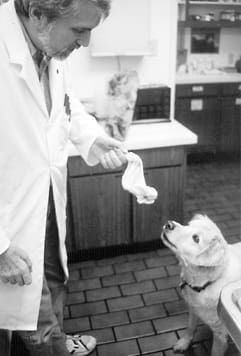For thousands of years, Mother Nature has fed her dogs and cats raw food. Their wild cousins continue to dine on freshly captured prey, but most American dogs and cats eat commercial pet foods from cans and packages or home-cooked grains and meats. The result, say a number of veterinarians and nutritionists, is deteriorating health in our canine companions. In response is a growing trend toward home-prepared diets for our dogs, away from cooked food and toward more natural fare. While commercial pet food companies developed and promoted their product lines in the 1940s and 50s, Afghan Hound breeder Juliette de Bairacli Levy fed her dogs raw meat, raw bones, raw goat’s milk, raw fish, raw eggs, and a variety of raw fruits, vegetables, nuts, and oils. Supremely healthy and intelligent, her dogs won numerous championships. De Bairacli Levy described her “Natural Rearing” philosophy in a series of books, and gained a devoted following around the world. Australian veterinarian Ian Billinghurst has converted many dog owners to raw food with his books Give Your Dog a Bone and Feed Your Pups with Bones. His well-known BARF diet (Bones and Raw Foods, or Biologically Appropriate Raw Foods) consists of raw meaty bones, occasional raw eggs or ripe fruit, small amounts of raw pureed vegetables, and other extras, such as kelp, herbs, and table scraps. Billinghurst does not use cooked grains, explaining that they contain relatively poor quality protein, interfere with calcium absorption, stress the pancreas, and contribute to mineral imbalances, allergies, and diabetes. Making the switch Although some dog owners have switched from cooked to raw in a single day without incident, such a drastic change can trouble some dogs. Here are some common-sense guidelines that help dogs and owners make a smooth transition to a new diet. First, change your dog’s feeding schedule. This is especially important if you’ve been leaving food out all day. In the wild, dogs hunt when they’re hungry, gorge themselves when they catch prey, and go hunting again on an empty stomach. No animal in the wild lounges beside a food dispenser. Feed your dog once or at most twice per day, wait 15 minutes, then pick up whatever is left over and put it away. Do this six days per week, and on the seventh day, give your dog only water. Young puppies, miniature or toy breeds, and dogs with certain illnesses should not be fasted for more than half a day (ask your veterinarian), but most dogs respond very well to this feeding cycle. They become more alert, attentive, and energetic – and no, it isn’t because they are starving. Removing food between meals and fasting one day a week gives their digestive organs a well-deserved rest and sharpens the body’s response to food. The younger, healthier, and more omnivorous the dog, the safer a rapid change from commercial pet food to raw fare. The older, less healthy, or more finicky the dog, the more important it is to move slowly. Most of the dogs whose owners I have surveyed made the change within a month or two, but some took as long as a year. If you have any question about your dog’s health before or during the transition, consult a holistic veterinarian or a breeder who has raised generations of your breed on an all-raw diet. Start by adding new food to old, maintaining the familiar taste and texture for as long as necessary. For young, active chow hounds in good health, combine 75 percent old food with 25 percent new food for a few days or a week, then feed half and half for a few days, and gradually reduce the old food to 25 percent or less, until the dog is eating all raw food. For older dogs, go more slowly. If your dog walks away from unfamiliar foods, hide a fraction of a teaspoon of raw meat in the middle of his dinner. After several days, add more. If your dog has a favorite treat, add it, too. One dog I know refused to taste raw meat changed his mind when his owner mixed it with his all-time favorite food, asparagus! Introducing raw meaty bones Most of the breeders and owners who feed a bone-based natural diet use whatever meaty bones are available at reasonable cost, such as lamb neck bones, chicken backs, and beef oxtails. To introduce a dog to raw bones, however, most experienced “raw feeders” use chicken wings or poultry necks. “I recommend gradually switching dogs from cooked to raw foods and smashing or grinding raw bones until the dog is eating a completely raw diet, without any grains, yeast, milk, or dairy products,” says Schultze. “If the dog has had digestive problems or has been on pharmaceutical drugs, especially antibiotics, within the past year, I would make the switch with the aid of digestive enzymes and non-dairy probiotics.” Probiotics are beneficial bacteria such as acidophilus. Start with a fraction of the amount recommended on the label, gradually increasing to the recommended dosage. Depending on its metabolism and activity level, a dog may need more or less, but two percent of its weight in raw meat and bones is a safe ballpark figure for a dog’s total ration of food (one pound for a 50-pound dog). To provide the stomach exercise that helps prevent bloating, meat should be whole or in large chunks, not minced or ground. De Bairacli Levy recommends that bones be fed last, after the raw meat and vegetables, so that they are cushioned in the stomach. Dogs new to bones often experience temporary diarrhea, constipation, or both as their systems adjust, especially if they eat large quantities. Remember to feed small amounts at first, start with bones that are easy to chew, smash them with a hammer to help your dog digest them, feed them last, and give adult dogs a digestive enzyme during the transition to raw food. Chicken wings and necks are perfect “first bones” for teething puppies. Ann Mandelbaum, who breeds Standard Poodles in Connecticut, introduced a recent litter of pups to raw chicken wings when they were four weeks old. “Every day I gave one wing to each pair of puppies and let them work on it together,” she says. “At first they gnawed most of the meat off and left the bones. By the middle of the week, they were nibbling on the ends, and by the end of the week, the bones were disappearing.” In addition to their nutritional benefits, raw bones provide dental floss in the form of gristle and tendons. “You can always tell a bone-chewing dog,” says holistic veterinarian Beverly Cappel, of Chestnut Ridge, New York. “They have the whitest, strongest, cleanest teeth.” Even when they appreciate the benefits of feeding raw bones, some owners are reluctant to provide them due to messiness (feed them outside!), because they have been frightened by veterinarians or another authority figure, or because they feel overwhelmed by the logistics of changing to a raw diet. Unfortunately, not including raw bones in a mostly-meat diet may create nutritional imbalances that cause serious harm. Billinghurst warns against the use of substitutes such as heat-sterilized bone meal and calcium supplements, for they can disrupt the natural balance of minerals in growing bodies and can cause, rather than prevent, hip dysplasia and other structural problems. There are over a hundred important elements in raw bones, bone marrow and connective tissue, all of which are vital to the health of joint cartilage, intervertebral discs, vascular walls and other parts of the canine body. Raw bones that are soft enough for your pet to bite through, swallow and digest contain all of these nutrients. A small number of commercial supplements made from cold-sterilized raw bones contain most of them (see “Raw Resources,” next page). If you are reluctant to feed your dog raw bones but want their nourishment, you can substitute either company’s products or you can grind raw meaty bones in a meat grinder, keeping in mind that supplements and freshly ground bones cannot provide the tooth-cleaning benefits, hours of chewing pleasure, or stomach exercise that raw meaty bones provide. What about bacteria? Healthy dogs in the wild can eat just about any raw meat and survive, if not thrive. However, dogs on commercial food may not produce all the hydrochloric acid and beneficial bacteria they need for protection from pathogens. If you are concerned about bacteria, you can disinfect large pieces of raw meat, raw bones, or eggs in the shell, soak them in a solution of 1/2 teaspoon original formula Clorox bleach per gallon water, several drops of 35-percent food-grade hydrogen peroxide in a sink of cold water (enough to create small bubbles but not enough to change the meat’s color), OR 1/2 teaspoon liquid grapefruit seed extract in a sink of cold water. Let stand 5 to 10 minutes, rinse by soaking in plain water, and drain. However, it should be mentioned that most raw feeders discontinue these disinfection practices as they gain confidence in their healthy dogs’ ability to handle any bacteria that may be present in their raw food. Most of the breeders and owners I have interviewed say their dog’s raw meals are surprisingly easy to prepare. Some buy their meat at the supermarket while others arrange bulk shipments of organically grown meat and bones through holistic veterinarians, co-ops, dog clubs, and local hunters. For convenience, some manufacturers prepare raw food for dogs and freeze it for shipping. “People are unnecessarily intimidated by raw-food diets,” says pet nutritionist Pat McKay, author of Reigning Cats and Dogs. “That’s unfortunate because it isn’t difficult or time-consuming. In fact, if you spend more than 10 minutes a day feeding your dog, you either love to be in the kitchen or you’re doing something wrong.” Also With This Article Click here to view “When Feeding a Raw Diet Use Safe Meat Handling Processes” Click here to view “How-To Books For Feeding Raw Diets” Click here to view “Raw Food Dog Diet Recipes” -By CJ Puotinen
The best in health, wellness, and positive training from America’s leading dog experts
© Belvoir Media Group, LLC. All rights reserved.







What digestive enzymes are recommended by name? One of my dogs has a hard time digesting even chicken feet.
Hi there I just get my dog and i was wondering if any of you recommend a good nutrition diet for my dog.